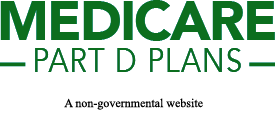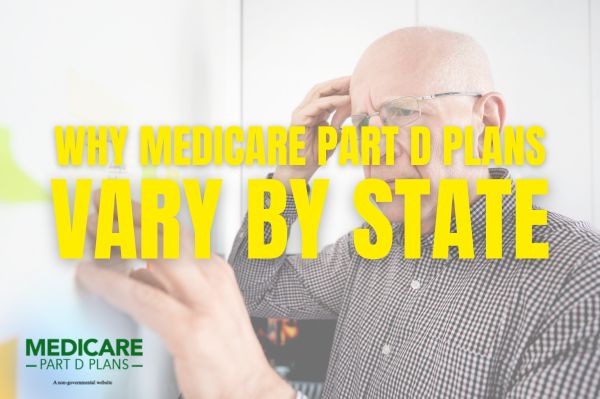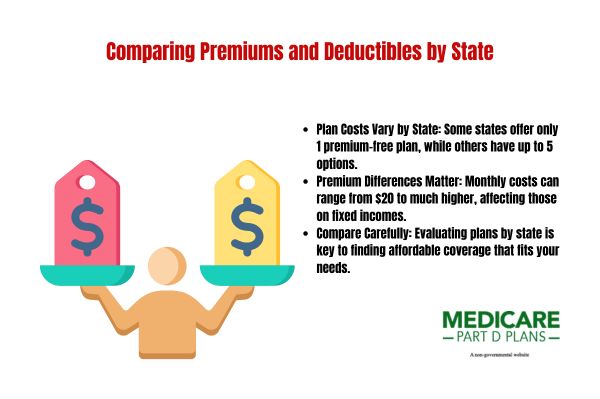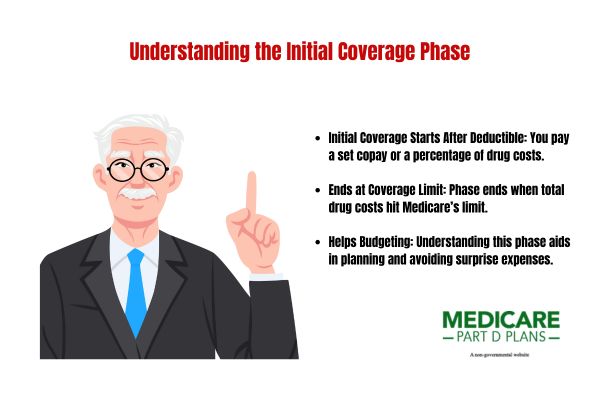Find a Medicare Part D prescription drug plan

Medicare Part D
Prescription Drug Coverage 2026
Compare Medicare Part D Plans by State: 2026 Guide
Looking to compare Medicare Part D Plans by state
Key Takeaways
- Medicare Part D Plans may vary by state due to demographic factors, state regulations, and provider networks, likely affecting coverage options and costs.
- Top-rated Medicare Part D Plans
in 2026 might feature lower copayments and expanded formularies, catering to regional healthcare needs.
- Beneficiaries can use this website to compare Medicare Part D plans by ZIP code, helping them find cost-effective options tailored to their healthcare needs.
Why Medicare Part D Plans Vary by State
Medicare Part D plans could potentially differ significantly between states for various reasons. These differences may arise from demographic factors like the age and health status of residents.
States with older populations or higher instances of chronic illnesses may have more diverse plan offerings tailored to meet these specific health needs.
State-specific regulations and local health policies might influence the availability and design of Medicare Part D plans. For instance:
- States may have varying rules governing the number of carriers and the competitiveness of available plans.
- Some states might impose stricter requirements on insurance providers.
- These regulations will likely affect the number and type of available Medicare Part D plans.
Provider networks and the competitiveness of the healthcare market in each state may also contribute to differences in Medicare Part D plans. Coverage options, premiums, and formularies—the list of drugs covered by a plan—may vary widely depending on the local regulations and the specific needs of the population.
These variations could potentially ensure that Medicare Part D plans may be tailored to meet the unique healthcare needs of residents in each state.
Top Part D Plans in Each Region
When it comes to selecting a Medicare Part D plan, knowing the top-rated options in your region could make a significant difference.
These features could potentially reduce certain out-of-pocket expenses and possibly provide greater access to necessary medications.
Certain plans may also include deductible caps and out-of-pocket caps for generic drugs, possibly making them attractive options for effectively managing healthcare costs. These plans might stand out for their comprehensive coverage options and customer satisfaction ratings, which vary by region.
Knowing the top plans in your region could help you make an informed choice that aligns with your healthcare needs and financial situation. Whether you need extensive drug coverage or specific benefits for chronic conditions, knowing the best options in your area will likely be crucial for optimizing your Medicare Part D coverage.
Comparing Premiums and Deductibles by State
The cost of Medicare Part D plans may vary significantly depending on the state you reside in. For instance:
- Some states may offer as few as one premium-free plan.
- Other states might provide up to five options, reflecting diversity in plan availability.
- This variability likely means beneficiaries in different states may pay significantly different amounts for the same medications.
For instance, some states might offer Part D plans with premiums as low as $20 per month, while others may have higher premiums due to fewer available options. The difference in premiums could impact beneficiaries’ choices, especially those on a fixed income who need to balance healthcare costs with other expenses.
The cost-effectiveness of Medicare Part D plans may vary widely, likely influencing beneficiaries’ decisions based on their financial situations.
In states with higher premiums and fewer plan options, beneficiaries might struggle to find a plan that meets their needs without straining their budget. Thus, comparing premiums and deductibles by state is crucial for making an informed decision about Medicare Part D coverage.
Recognizing these differences could help you choose a plan that fits your budget and offers the necessary coverage for your prescription medications.
By carefully evaluating the available options and their associated costs, you could potentially ensure that your Medicare Part D plan aligns with your healthcare needs and financial circumstances.
Availability and Rankings of Carriers
Selecting the right Medicare Part D plan will likely involve considering the availability and rankings of different carriers. For instance:
- The availability of benchmark plans may vary significantly across states.
- Benchmark plans could be crucial for low-income beneficiaries as they will likely provide basic coverage at a lower cost.
- Benchmark plans could be an important option for those who qualify for financial assistance.
Carriers’ performance and availability may differ widely between states, likely influenced by local regulations and market competitiveness. Plans are evaluated based on Star Ratings, which assess quality and performance metrics.
These ratings could provide insight into a plan’s overall effectiveness and customer satisfaction, possibly making them an important factor to consider when selecting a plan.
Beneficiaries should weigh both coverage options and cost-effectiveness when choosing a Medicare Part D plan carrier.
Evaluating Star Ratings and understanding the availability of benchmark plans could help you make an informed decision to ensure you receive the best possible eligible coverage for your needs.
Enrollment Tools for Specific ZIP Codes
Enrollment tools that cater to specific ZIP codes can simplify finding the right Medicare Part D plan. Entering your zip code into the Plan Finder Tool on this website lets users compare different Medicare Part D plans based on their specific location.
By using this website, beneficiaries can compare available Medicare advantage plans and make informed decisions about their healthcare coverage. Our website offers detailed information about the potential costs, coverage options, and possible benefits of each Medicare advantage plan, helping you choose the one that best meets your needs.
If you’re looking for a plan with the lowest out-of-pocket costs for your medications, the plan finder tool can help you identify which plans in your area offer the best value. This personalized approach likely ensures you choose a plan that aligns with your healthcare needs and financial situation.
Understanding the Initial Coverage Phase
The initial coverage phase of Medicare Part D starts after you reach your deductible, or if your plan has no deductible. During this phase, beneficiaries may pay either a fixed copayment or a percentage of the drug cost. This payment structure will likely manage medication costs by distributing expenses over time.
The initial coverage phase ends once total expenditures for covered drugs reach the Medicare-specified initial coverage limit. Some Medicare drug plans might allow members to spread out their drug costs over the month’s supply, possibly helping to manage monthly expenses more effectively.
Grasping the initial coverage phase is crucial for managing your prescription drug costs. Knowing when this phase begins and ends could help you plan your healthcare expenses and potentially avoid unexpected costs.
Navigating the Coverage Gap Phase
After the initial coverage phase, beneficiaries enter the coverage gap phase, also known as the donut hole. This phase begins after a certain amount has been spent on covered part medications, which might lead to higher out-of-pocket costs until reaching catastrophic coverage.
During the coverage gap, individuals may bear a higher share of prescription costs, which could be a significant financial burden.
Understanding the coverage gap phase will likely be vital for planning your prescription drug expenses and avoiding unexpected costs.
Navigating the coverage gap phase might be challenging, but knowing the criteria for exiting it could help manage your healthcare costs more effectively. Planning and considering additional assistance programs could potentially minimize the financial impact of the coverage gap.
Catastrophic Coverage Period Explained
The catastrophic coverage period in Medicare Part D may include the following points:
- It starts after beneficiaries reach a certain out-of-pocket spending limit, possibly providing significant financial relief.
- During this phase, Medicare Part D plans will likely offer a standard benefit package to ensure a baseline level of coverage.
Once in the catastrophic coverage phase, a beneficiary might not have to pay out-of-pocket responsibility for covered drugs for the rest of the year. This phase could potentially provide substantial financial help, possibly ensuring beneficiaries could access necessary medications without prohibitive costs.
Understanding the initial coverage period and the catastrophic coverage period is vital for managing your healthcare expenses. Knowing when this phase begins and its potential benefits could help you better plan your prescription drug costs and possibly avoid unexpected financial burdens.
See plans in your area instantly!
Advertisement
Low-Income Subsidy (Extra Help) Program
The Low-Income Subsidy (Extra Help) Program will likely offer financial assistance to Medicare beneficiaries with limited incomes and resources. Eligibility for the Extra Help program is based on an applicant’s income and resources, and individuals may apply at any time, even before enrolling in a Part D plan.
This program could potentially reduce costs associated with Medicare Part D, likely making it a vital option for those who qualify.
To help alleviate costs during the coverage gap, beneficiaries should explore assistance programs like Extra Help, which could potentially reduce out-of-pocket expenses. Applying for the Extra Help program will likely require documents like bank statements, tax returns, and account balances.
Beneficiaries may also explore Medicare Savings Programs and pharmaceutical assistance programs from drug manufacturers to help cover certain medication costs and drug benefit.
These programs will likely offer additional financial support, possibly ensuring beneficiaries could afford their Medicare prescription medications.
Possible Changes to Medicare Part D Benefits
Potential changes to Medicare Part D benefits might stem from modifications outlined in the Inflation Reduction Act. Starting in 2025, Medicare might reduce some of its share of costs in the catastrophic phase, possibly shifting more financial responsibility to Part D plans and drug manufacturers.
Potential changes in coverage and cost-sharing might include:
- The coverage gap phase may be eliminated by 2025, possibly simplifying cost-sharing for enrollees.
- Part D plans may cover up to 20% of drug costs during the catastrophic phase.
As of 2023, monthly costs for covered insulin might be limited to a maximum of around $35 across all Part D plans. Medicare beneficiaries with Part D coverage may also benefit from the potential cap on out-of-pocket costs set around $2,000 starting in 2025.
These potential changes will likely aim to make prescription drugs more affordable and accessible for all beneficiaries.
How to Protect Against Medicare Fraud
Protecting yourself against Medicare fraud will likely be essential for safeguarding your personal information and ensuring that you receive the benefits you’re entitled to.
Keep your Medicare number and personal information secure; do not share it except with trusted healthcare providers. Be aware that Medicare will never contact you to sell services or request personal information outside of specific situations.
To protect yourself from Medicare fraud, follow these steps:
- Regularly verify your Medicare statements against your calendar to ensure all billed services were actually received.
- If you suspect Medicare fraud, report it by calling 1-800-MEDICARE or online through official channels.
- Do not accept offers of money or gifts in exchange for free medical services, as this could lead to fraud.
By following these tips, you can protect yourself from Medicare fraud and ensure that your healthcare benefits are used appropriately.
Additional Resources for Beneficiaries
Medicare beneficiaries have access to a variety of resources that can help them navigate their healthcare options. One key resource is State Health Insurance Assistance Programs (SHIPs), which:
- Offer free, unbiased counseling for Medicare beneficiaries
- Provide valuable information and support
- Help beneficiaries make informed decisions about their healthcare coverage.
Other useful resources might include guides, explainer videos, and educational webinars designed to assist Medicare beneficiaries. These resources cover a wide range of topics, from understanding Medicare Part D plans to applying for financial assistance programs.
By utilizing these additional resources, beneficiaries may better understand their healthcare options and make informed decisions about their Medicare Part D coverage. Whether you’re looking for personalized counseling or educational materials, these resources could provide the support you need.
Find a Plan and Enroll Online Yourself!
Advertisement
Summary
Understanding the variations in Medicare Part D plans by state will likely be crucial for making informed decisions about your healthcare coverage.
From recognizing the potential impact of demographic factors and state-specific regulations to comparing possible premiums and deductibles, this article has provided a comprehensive overview of the key aspects of Medicare Part D plans.
The top-rated plans in each region, the availability and rankings of carriers, and the use of enrollment tools for specific ZIP codes will likely be essential factors to consider when selecting a plan. Additionally, understanding the different phases of coverage, the Low-Income Subsidy (Extra Help) Program, and potential changes to benefits could help you manage your prescription drug costs more effectively.
By staying informed and utilizing the resources available, you may optimize your Medicare Part D coverage and ensure that you receive the best possible healthcare benefits. Make informed choices and take control of your healthcare journey with confidence.
Frequently Asked Questions
Why do Medicare Part D plans vary by state?
Medicare Part D plans may vary significantly by state primarily due to demographic factors, local regulations, and the competitiveness of the insurance market in each region. These differences will likely impact on the availability, cost, and structure of the plans offered to beneficiaries.
How can I find the top-rated Medicare Part D plans in my region?
To find top-rated Medicare Part D plans in your region, enter your zip code into the Plan Finder Tool on this website. Our website allows you to compare plans and offers personalized estimates of costs and coverage options.
What is the Low-Income Subsidy (Extra Help) Program and how does it work?
The Low-Income Subsidy (Extra Help) Program will likely offer financial aid to Medicare beneficiaries with limited incomes, potentially lowering certain Medicare Part D costs. To qualify, individuals must meet specific income and resource criteria, and applications can be submitted throughout the year.
What are the recent changes to Medicare Part D benefits that I should be aware of?
Potential changes to Medicare Part D benefits might include a cap of around $35 on monthly insulin costs, and an out-of-pocket cost cap of about $2,000 starting in 2025. These modifications will likely be part of the Inflation Reduction Act.
How can I protect myself from Medicare fraud?
To safeguard yourself against Medicare fraud, ensure your Medicare number and personal information are secure, regularly review your Medicare statements, and promptly report any suspicious activity to 1-800-MEDICARE. Being cautious of unsolicited offers and not sharing personal details with unknown parties is essential.
Begin Choosing your plan
Advertisement
ZRN Health & Financial Services, LLC, a Texas limited liability company.



